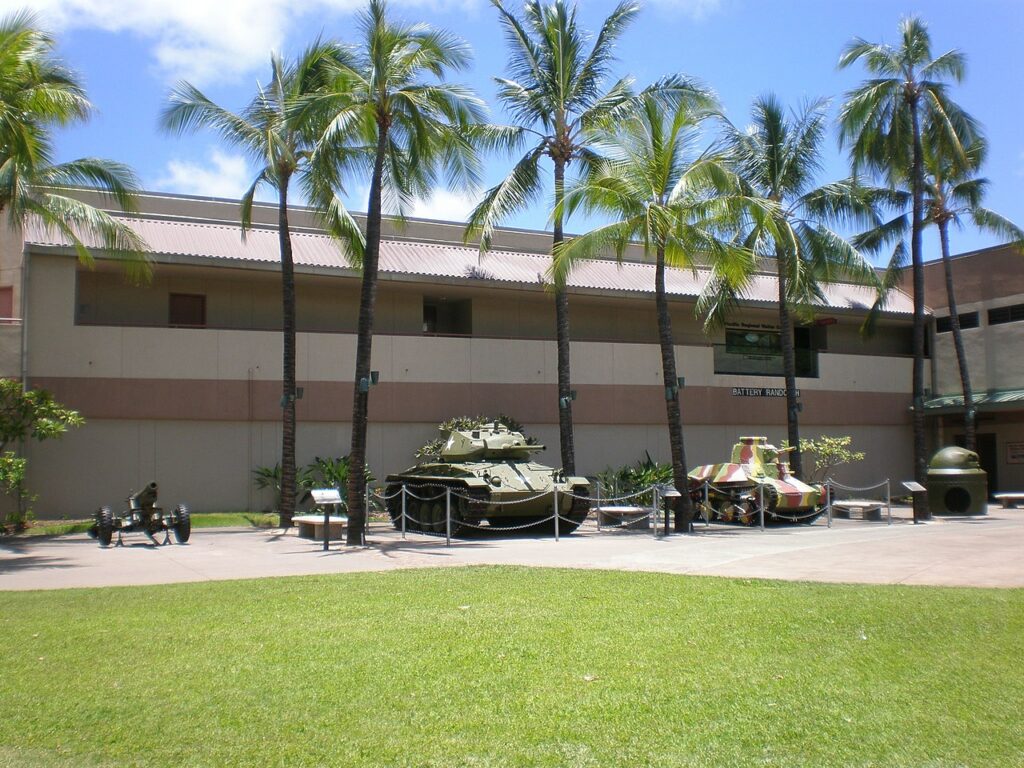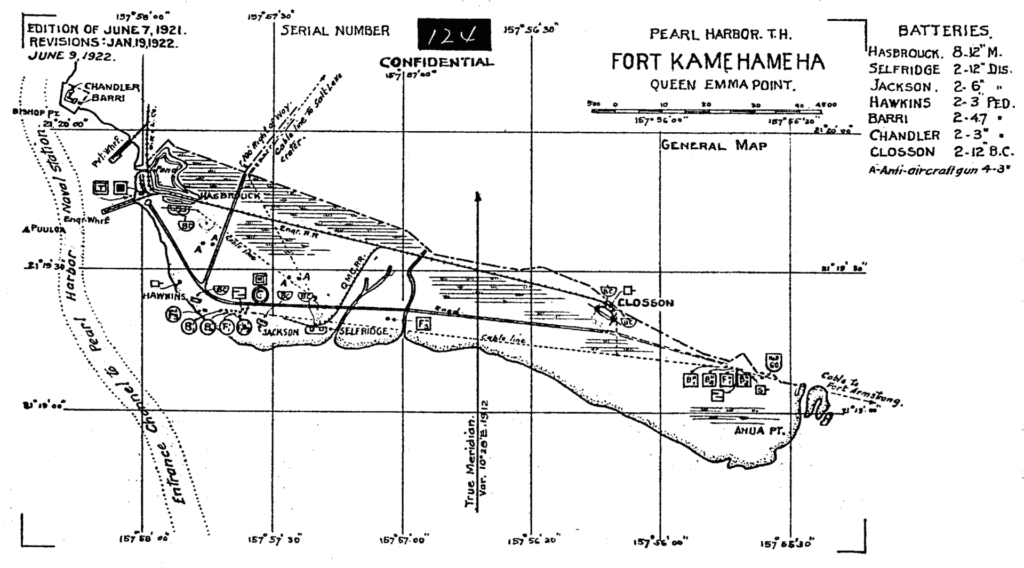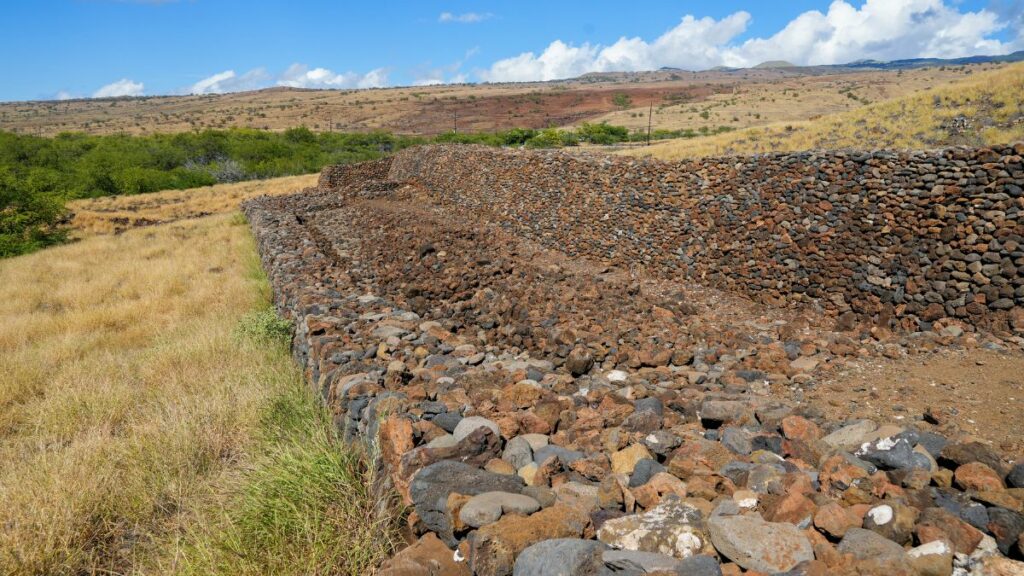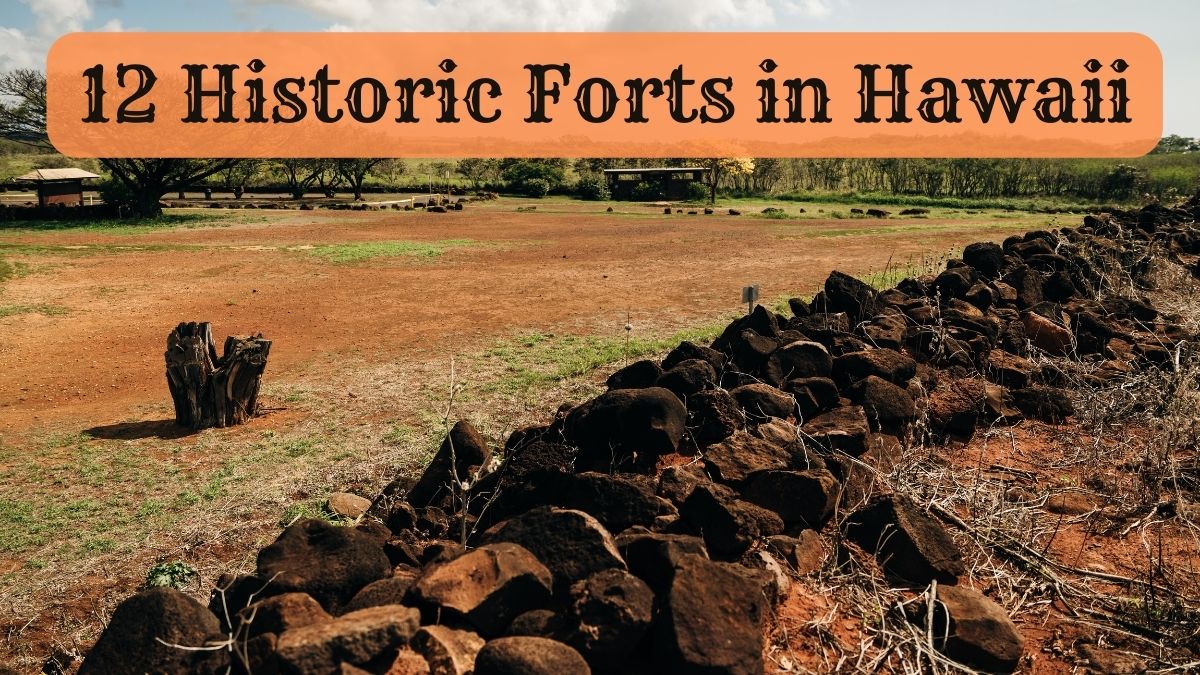The Hawaiian Islands are an archipelago of immense natural beauty and strategic significance.
They host a series of historic forts in Hawaii that whisper tales of ancient Hawaiian culture, early European contact, and pivotal moments in the history of the United States.
These forts not only served as military strongholds but also played an essential role in shaping the history and foreign affairs of the region. Let’s embark on a historical exploration of these formidable structures that have stood the test of time.
Historic Forts in Hawaii
| 1. Fort DeRussy | 7. Camp McKinley |
| 2. Fort Elizabeth | 8. Fort Hase |
| 3. Fort Kamehameha | 9. Fort Barrette |
| 4. Pu’ukohola Heiau | 10. Fort Armstrong |
| 5. Fort Ruger | 11. Mailekini Heiau |
| 6. Ulupo Heiau State Historic Site | 12. Fort Weaver |
1. Fort DeRussy: Waikiki’s Military Legacy

Fort DeRussy, initially constructed as an army post, was named after Brigadier General Rene Edward De Russy, a noted military engineer with the Army Corps of Engineers.
Its location in Honolulu, on the island of Oahu, strategically positioned it to protect the United States’ interests in the Pacific. Over time, Fort DeRussy evolved from a traditional coastal fortification into a hub of recreation and learning.
World War II and Beyond
During World War II, Fort DeRussy played a critical role as a staging area for soldiers. As the war concluded, it transitioned into an R&R destination for military personnel.
Today, its grounds are home to the U.S. Army Museum of Hawaii, where visitors can explore exhibits ranging from ancient Hawaiian weaponry to the modern-day conflicts that have shaped Hawaii’s military significance.
The museum, which opened its doors to the public in the 1970s, is housed in Battery Randolph, a former gun battery and coastal defense fortification that contains historical artifacts such as military vehicles, weapons, and personal items from soldiers stationed in Hawaii.
Location and Accessibility
Situated within walking distance of Waikiki’s famous beaches, Fort DeRussy offers a respite from the urban hustle and a chance to delve into the military history that has shaped the Hawaiian Islands.
The fort and museum are easily accessible to visitors, providing a glimpse into the military past and a green space for relaxation.
2. Fort Elizabeth on the Island of Kauai

The story of the old Russian fort known as Fort Elizabeth, located on the island of Kauai near Waimea Bay, begins with the ambitions of the Russian-American Company.
In the early 19th century, specifically around 1817, Russian traders, under the directive of the Russian government, sought to extend their reach into the Pacific.
They allied with King Kaumualii, who sought Russian support to regain his autonomy from King Kamehameha I.
The Fort’s Decline and Legacy
Despite its name, Fort Elizabeth was not built by the Russian government but somewhat under the supervision of the Russian-American Company with the help of native Hawaiians.
Fort Barclay-de-Tolly was one of three forts constructed by the company to establish a provisioning base for Russian ships.
However, by 1817, the Russian flag was lowered, and the fort’s control was short-lived due to the intervention of King Kamehameha I and the eventual decline of the Russian-American Company’s influence after the Russian government lost interest in the region.
Today, the fort’s remains can be found at the Russian Fort Elizabeth State Historical Park, where visitors can see the massive cubic yards of its coral blocks that once composed the formidable structure.
It is a unique historical site that encapsulates the global aspirations of the early 19th century, marking the farthest reach of Russian influence in the Hawaiian Islands.
3. Fort Kamehameha: Standing Guard over Pearl Harbor

Fort Kamehameha has historical significance as a pivotal military installation for the United States, especially during critical periods such as World War II.
Its establishment in 1907 was part of a more significant strategic effort known as the Endicott Program, a series of fortifications initiated after the Spanish-American War to protect American harbors from naval threats.
Strategic Importance and Operations
Located at the entrance of Pearl Harbor, Hawaii, Fort Kamehameha was one of several forts built to protect the naval base, which was crucial for the US Navy’s operations in the Pacific.
It was named in honor of King Kamehameha the Great, who was celebrated for uniting the Hawaiian Islands in the early 19th century, symbolizing the fort’s role in defense and unity.
As a coastal artillery fort, it was outfitted with a battery of long-range guns capable of striking ships before they could enter the harbor. During World War II, the attack on Pearl Harbor on December 7, 1941, by Japanese forces highlighted the fort’s strategic location.
Although the fort itself was not the primary target, its presence and operational capacity were integral to the subsequent fortification and defense of the area.
Surviving Change and Modernization
After the attack on Pearl Harbor, American military strategies underwent significant changes, with a shift towards more mobile and technologically advanced forms of warfare, such as air power and nuclear weapons.
This shift made static coastal defenses like those at Fort Kamehameha largely obsolete.
In the years following World War II, the military continued to use the fort, although its role and structures were repurposed.
The advent of guided missiles and modern naval warfare meant that the big guns of Fort Kamehameha were no longer necessary. Over time, the fort’s land became valuable for other military installations, such as airfields.
Decommissioning and Legacy
The decommissioning of Fort Kamehameha came as the military reassessed the utility of such installations. Despite this, the fort’s historical significance has been recognized.
Some of the land was repurposed to expand Hickam Air Force Base, eventually merging with the Naval Base Pearl Harbor to become Joint Base Pearl Harbor-Hickam.
The remnants of Fort Kamehameha serve as a poignant reminder of the evolution of military strategy, technology, and the impact of global conflict on local territories. The site’s remaining structures, such as old gun batteries and bunkers, have become historical sites.
4. Pu’ukohola Heiau

Pu’ukohola Heiau, the monumental temple on the Big Island of Hawaii, is an awe-inspiring historical structure that has withstood the test of time, serving as a significant cultural and historical icon of the Hawaiian people.
Commissioned by King Kamehameha the Great, the construction of the heiau was both a spiritual undertaking and a highly strategic move in his campaign to consolidate power and unify the Hawaiian archipelago.
Construction and Significance
The construction of Pu’ukohola Heiau was an engineering marvel of its time, involving the manual transportation of massive stones without using metal tools or wheeled vehicles.
According to historical accounts, thousands of people formed human chains along the hillsides, passing the stones from hand to hand in a show of unity and communal effort.
The name “Pu’ukohola” translates to “Whale Hill” in Hawaiian, indicating the heiau’s location overlooking a site where sharks and whales were often seen. Its dedication to the war god Kūkā‘ilimoku, a deity revered by Kamehameha, demonstrated the king’s devotion and desire for divine favor in his quest to unite the islands.
Cultural and Political Role
The completion of Pu’ukohola Heiau marked a pivotal moment in Hawaiian history. It was not only a religious center, but also a place where political alliances were forged, and strategies for unification were developed.
The presence of the heiau underscored the significant role of spirituality and religion in Hawaii’s social and political realms at the time.
The rituals and offerings conducted at the heiau were believed to grant Kamehameha the spiritual support needed to achieve his ambitious political goals. His eventual success in unifying the islands solidified the temple’s reputation as a powerful symbol of unity and strength.
Preservation and Education
Declared a National Historic Landmark in 1962 and now managed by the National Park Service, Pu’ukohola Heiau is a testament to the enduring legacy of Hawaiian cultural and architectural ingenuity.
Preservation efforts have stabilized and restored the site, ensuring that visitors can witness the grandeur of this ancient structure and learn about the sophisticated society that constructed it.
Today, Pu’ukohola Heiau is a place for visitors to connect with Hawaii’s past and a living cultural center.
The heiau continues to host ceremonies and celebrations that honor Hawaiian traditions, allowing Native Hawaiians to maintain a deep connection with their heritage. These events are often educational, providing insights into ancient Hawaiian practices, beliefs, and societal structures.
The site is a focal point for perpetuating Hawaiian language, dance, music, and other cultural practices.
Through educational programs, workshops, and guided tours, the National Park Service and local cultural practitioners work together to inform the public about the significance of the heiau and its role in Hawaiian history.
5. Fort Ruger: Diamond Head’s Military Might

Fort Ruger, established within the Diamond Head crater on Oahu, was the first military reservation in Hawaii, created after the United States annexed the islands.
It was critical to America’s coastal defense strategy to shield Honolulu and the Hawaiian Islands from naval attacks.
The fort was initially outfitted with heavy artillery and gun batteries, part of a comprehensive defensive ring around the island’s key harbors.
These fortifications responded to the growing need for security in the Pacific region and reflected the military foresight of the time.
Transformation and Current Use
Advancements in warfare technology and changing military tactics after World War II made static coastal defenses like those at Fort Ruger obsolete. This led to the partial decommissioning of the fort.
Today, Fort Ruger still serves the military community, with portions of the facility used by the Hawaii National Guard. This repurposing aligns with contemporary military requirements while maintaining a connection to the site’s historical roots.
Preservation of Military Heritage
The remnants of Fort Ruger’s historical structures, including bunkers and old battery placements, are preserved as markers of military innovation from the early 1900s.
These structures provide a window into the past and the early strategic efforts to protect the United States’ interests in the Pacific.
6. Ulupo Heiau State Historic Site

Located on Oahu’s windward side, Ulupo Heiau is an ancient Hawaiian sacred site, believed to have been constructed around the 12th century. Initially, its massive stone platform was a ceremonial structure for the native Hawaiians.
As centuries passed, the site’s use evolved in response to the shifting needs of the Hawaiian people.
Notably, in the 19th century, when Hawaii began to experience new external threats, the heiau was repurposed as a fort, with its walls augmented by cannons.
Preservation and Education
Today, Ulupo Heiau is recognized and maintained as a state historic site. This designation is a testament to its importance as a cultural and historical symbol, connecting current and future generations to the Hawaiian past.
The heiau’s preservation allows it to serve as an educational resource that highlights the enduring strength of native Hawaiian culture.
It is a reminder of how Hawaiian society has persevered and adapted throughout history, and the site continues to educate visitors on the complexities and richness of the islands’ heritage.
7. Camp McKinley
Camp McKinley was founded in Honolulu as a direct result of the United States’ annexation of Hawaii in 1898. This former military installation was part of the strategic expansion of U.S. military presence in the Pacific.
Throughout its operational years, Camp McKinley served various military purposes, adapting to the needs of the U.S.
Armed Forces as they expanded their strategic reach across the Pacific region during pivotal times in history, such as World War II.
Post-Military Legacy and Commemoration
After its decommissioning, the site of Camp McKinley has undergone significant changes.
The exact fate and current status of the land previously occupied by the camp may involve repurposing for civilian use or incorporation into other military facilities.
Though Camp McKinley no longer functions as a military base, its historical significance as part of the early American military expansion in Hawaii remains of interest to historians and the public.
It is a historical marker representing the transitional period following Hawaii’s annexation and the ensuing changes in the Pacific geopolitical landscape.
8. Fort Hase
Fort Hase, situated on what is now Marine Corps Base Hawaii, was established in the early 20th century as a coastal artillery fort.
Its primary purpose was to strengthen the coastal defenses aligned with the United States military strategy in the Pacific.
As a coastal artillery fort, Fort Hase was part of a broader network of fortifications designed to protect the Hawaiian Islands from potential maritime threats.
The fort’s establishment reflected the era’s strategic military concerns and the evolving nature of naval warfare.
Transition and Current State
With the advancement of military technology and the changing nature of global threats, the role of static coastal artillery posts like Fort Hase has diminished.
The infrastructure at Fort Hase has since been adapted for contemporary military use by the Marine Corps.
While Fort Hase has transformed over the years, it remains an integral part of the history of Marine Corps Base Hawaii.
It stands as a testament to the evolution of military strategy and defense mechanisms from its inception to the present day.
The site encapsulates a specific period of military architecture and planning, offering insights into the past priorities and defense tactics of the United States.
9. Fort Barrette
Fort Barrette, located in Kapolei, Oahu, was constructed to defend Pearl Harbor.
The fort was one of several installations equipped with large coastal artillery guns, a testament to the United States’ strategic emphasis on safeguarding its Pacific Fleet anchored at Pearl Harbor.
The large guns at Fort Barrette underscored the fort’s role as a formidable deterrent against naval threats.
The coastal artillery was designed to repel enemy ships and protect the vital naval installations at Pearl Harbor, which were crucial to America’s Pacific defense strategy.
Evolution and Legacy
With advancements in military technology and warfare tactics, the necessity for such coastal artillery diminished, leading to the deactivation of Fort Barrette’s artillery operations.
The current status of the fort and its structures may vary, and they could be repurposed for other military uses or public development.
Although no longer in active military use, Fort Barrette’s historical impact as a defensive stronghold is recognized during a critical period of military history.
It is a physical reminder of the strategic military preparations the United States undertook in the early and mid-20th century.
The site contributes to the collective memory of the defense of Pearl Harbor and the broader narrative of World War II and subsequent military developments in the region.
10. Fort Armstrong
Fort Armstrong, constructed in 1907 along the shoreline of Honolulu Harbor, was part of the United States’ efforts to fortify its defenses in key strategic locations.
Its establishment coincided with a significant military buildup, particularly in the Pacific theater.
Throughout both World Wars, Fort Armstrong played a crucial role. During World War II, it was an active component of the military infrastructure vital for operations in the Pacific, serving various logistical and defensive functions.
Post-War Developments and Current Context
Following the end of World War II, the operational need for facilities like Fort Armstrong decreased, leading to a reevaluation of their strategic importance.
The transition from traditional coastal defenses meant the fort was repurposed or decommissioned.
Fort Armstrong’s historical importance lies in its association with the defense of Honolulu Harbor and its activity during periods of global conflict.
The site is a part of the military history of Oahu and reflects the broader shifts in military strategy and technology of the 20th century.
Its existence provides continuity to the narrative of Honolulu’s development and the protection of its harbor through tumultuous times in history.
11. Mailekini Heiau

Mailekini Heiau, once a sacred Hawaiian temple, underwent significant changes at the end of the 18th century when John Young, an advisor to King Kamehameha I, fortified it.
This adaptation reflects a period in Hawaiian history where Western influences began intermingling with native traditions.
The heiau’s conversion involved the installation of cannons, marking a shift from its traditional religious function to that of a defensive structure.
This transition to a Western-style fort indicated Hawaii’s changing political and social landscape, as the islands faced new pressures and external threats.
Historical Relevance and Preservation
Mailekini Heiau’s transformation from a religious site to a fortified position represents a unique cultural and practical adaptation. The site offers historical insights into the ways native Hawaiian structures were repurposed to meet the needs of the era, incorporating new technologies and strategies.
The historical significance of Mailekini Heiau endures as it sits below the larger and more recognized Pu’ukohola Heiau.
Its presence offers a physical representation of the pivotal era at the end of the 18th century when the Hawaiian Islands were uniting under King Kamehameha’s rule, and the influence of Western advisors was becoming more pronounced.
12. Fort Weaver

Fort Weaver, situated in Ewa Beach, was integral to Oahu’s coastal defense system throughout the 20th century. Its creation was part of a strategic initiative to safeguard the island from potential maritime threats.
Fort Weaver was equipped to protect the approaches to Pearl Harbor and other vital military and economic assets on Oahu as a defensive installation. It stood among several fortifications designed to form a defensive shield for the island.
Transition and Historical Significance
Over time, as the nature of military threats and defense technologies evolved, Fort Weaver’s role was adapted to fit the new paradigms of warfare and defense. Its coastal guns, once essential for Oahu’s defense, became relics of an earlier era of military strategy.
Fort Weaver’s legacy is tied to its role in the broader context of Oahu’s military history, particularly during heightened global conflict such as World War II.
The site encapsulates a segment of history dedicated to developing and implementing coastal defense systems in Hawaii.
Related: 10 Historic Forts in Nebraska
Conclusion – Historic Forts in Hawaii
The historic forts of Hawaii, from the imposing battlements of Fort Ruger to the repurposed ramparts of Fort Hase, serve as enduring monuments to the islands’ rich military past.
As visitors walk through the grounds that once echoed with the footsteps of soldiers and the commands of officers, these sites—now silent—continue to narrate tales of strategic defense and the readiness for naval attack that marked a time of war.
The U.S. Army Museum of Hawaii is a custodian of this storied heritage, offering a detailed account of these fortifications’ pivotal role in shaping Hawaii’s history.
Each army base, with its distinctive officers’ quarters and old batteries, provides a unique window into the daily lives of the military personnel who once operated within these walls.
Hawaii’s martial history narrative would be incomplete without mentioning the Russian Fort Elizabeth State Park. It reminds us of the global interplay of colonial powers on the Hawaiian archipelago, marking the influence of the first Westerners who sought to leave their footprint on these shores.

Cory is a website owner and content creator who enjoys fishing, history, coin collecting, and sports, among other hobbies. He is a husband and father of four.
Romans 15:4 For whatever was written in former days was written for our instruction, that through endurance and through the encouragement of the Scriptures we might have hope.


these were tartarian star forts for electricity not russian military forts